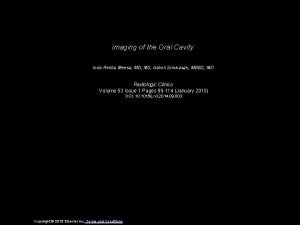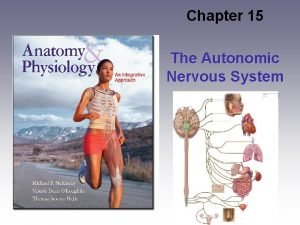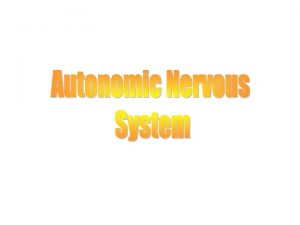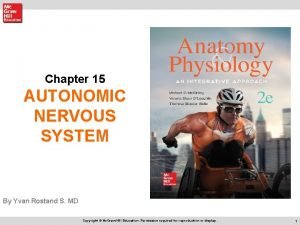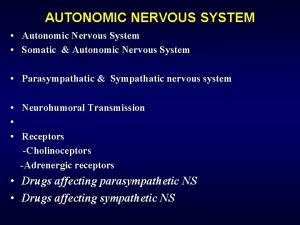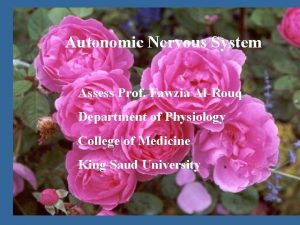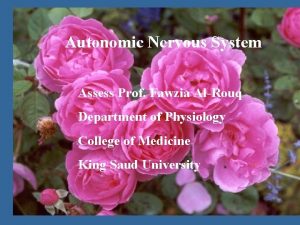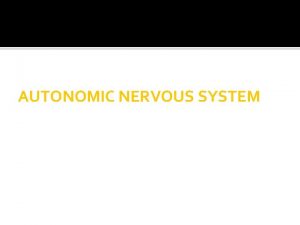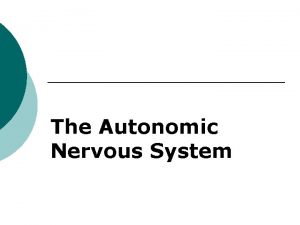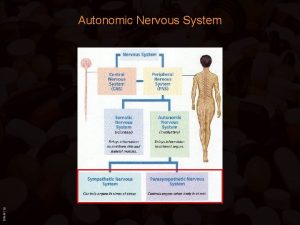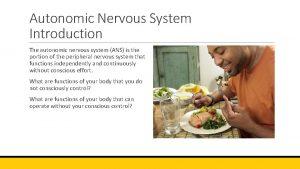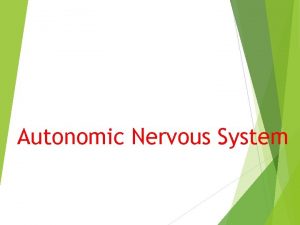Autonomic Nervous System Prof K Sivapalan Autonomic Nervous














![Adrenergic Receptors • Noradrenaline [norepinephrine] and adrenaline [epinephrine] are known as catecholamines. • The Adrenergic Receptors • Noradrenaline [norepinephrine] and adrenaline [epinephrine] are known as catecholamines. • The](https://slidetodoc.com/presentation_image/6194670b6708916e8e0cba86b55371fb/image-15.jpg)
- Slides: 15

Autonomic Nervous System Prof. K. Sivapalan

Autonomic Nervous System. • Visceral function is regulated by autonomic reflexes and endocrines. • Many reflexes are coordinated at spinal levelbladder, rectum, and sexual reflexes- input from higher centers also. • Blood pressure, respiration, swallowing, coughing, sneezing, gagging and vomiting are coordinated in brain stem- medulla oblongata. • Light reflex is coordinated in midbrain. • Temperature regulation and many complex mechanisms are coordinated in hypothalamus. 9/24/2020 Thalamus & hypothalamus 2

Comparison Somatic NS Autonomic NS • Voluntary • Involuntary • External sensory and motor • Internal sensory and motor • Motor- 1 neuron • Motor- 2 neurons • Sensory in dorsal horn, motor in ventral horn • Sensory in dorsal part of lateral horn, Motor in ventral part of lateral horn. May 2013 Autonomic Nervous System 3

May 2013 Autonomic Nervous System 4

Divisions of ANS Sympathetic Parasympathetic • Thoraco-lumbar outflow T 1 to L 2 • Cranio-sacral outflow – 3, 7, 9, 10 and S-2, 3, 4 • Short preganglionic • Long preganglionic • Preganglionic endingacetyl choline • Post ganglionicnoradrenalin, others in some areas • Post ganglionic- acetyl choline, others in some areas • Fight or flight - catabolic • Anabolic May 2013 Autonomic Nervous System 5

May 2013 Autonomic Nervous System 6

General Facts • Most organs- dual innervation with opposing effects • Exceptions- blood vessels, reproductive function • Preganglionic- myelinated [white rami] • Postganglionic- nonmyelinated [gray rami] May 2013 Autonomic Nervous System 7

May 2013 Autonomic Nervous System 8

May 2013 Autonomic Nervous System 9

May 2013 Autonomic Nervous System 10

May 2013 Autonomic Nervous System 11

Receptors • Any cell responds to chemical substances only if they bind with a receptor. • The chemical may be a neuro-transmitter or a hormone • The receptor may be located on the cell membrane, in the cytoplasm or in the nucleus • Substances that bind to receptors in side the cell will have to go through the cell membrane • Most of the receptors are located on the outer surface of the cell membrane and also to effector molecules in the membrane or in the interior of the cell. • They sometimes act directly and some times through second messangers May 2013 Autonomic Nervous System 12

Receptors for Neurotransmitters • Chemicals released from the nerve endings are called neuritransmitters • They generally increase or decrease permeability of specific ions by acting on the ligand gated channels • Alteration of sodium or potassium permiability will depolarize or hyperpolarize the membrane. • Alteration of calcium permiability may, in addition, bring about change in the action directly • Another mechanism is being linked to an enzyme such as adenylyl cyclase leading to formation of c. AMP. • The action of autonomic nerves on the effector organs depends on the transmitter and more importantly on the type of receptor and its associated mechanisms May 2013 Autonomic Nervous System 13

Acetyl Choline Receptors • Structure • Nicotinic and muscarinic receptors • Muscarine is a poison from toadstool [a fungus] • Muscarinic receptors are found in effectors innervated by post ganglionic cholinergic endings • Nicotinic receptors are found in autonomic ganglia and in motor end plates May 2013 Autonomic Nervous System 14
![Adrenergic Receptors Noradrenaline norepinephrine and adrenaline epinephrine are known as catecholamines The Adrenergic Receptors • Noradrenaline [norepinephrine] and adrenaline [epinephrine] are known as catecholamines. • The](https://slidetodoc.com/presentation_image/6194670b6708916e8e0cba86b55371fb/image-15.jpg)
Adrenergic Receptors • Noradrenaline [norepinephrine] and adrenaline [epinephrine] are known as catecholamines. • The receptors are categorised into alpha [α] and beta [β]. Each one is further subdivided into 1 and 2. The classification is based on the specific substances that stimulate and inhibit the functions. • Noradrenaline excites mainly α receptors and to a lessor extent on β receptors. • Adrenaline acts on both receptors equally. May 2013 Autonomic Nervous System 15
 Rekha sivapalan
Rekha sivapalan Ans
Ans Somatic nervous system
Somatic nervous system Autonomic nervous system consists of
Autonomic nervous system consists of Autonomic receptors
Autonomic receptors Spinal cord dorsal and ventral roots
Spinal cord dorsal and ventral roots Autonomic nervous system
Autonomic nervous system The autonomic nervous system controls
The autonomic nervous system controls Parasympathetic and sympathetic
Parasympathetic and sympathetic Autonomic dysreflexia
Autonomic dysreflexia Nervous system flow chart
Nervous system flow chart Label the different types of neuronal pools in the figure.
Label the different types of neuronal pools in the figure. Nervous
Nervous Processes of neuron
Processes of neuron Autonomic nerveous system
Autonomic nerveous system Nervous system and digestive system
Nervous system and digestive system
